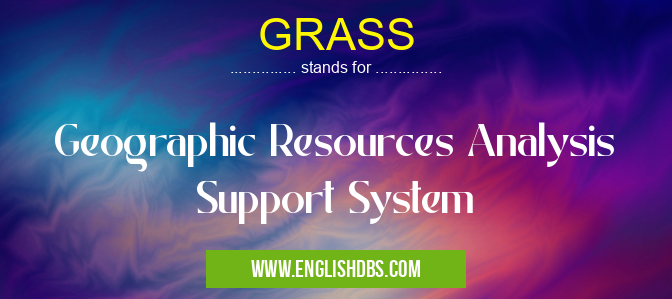What does GRASS mean in OCEAN SCIENCE
Geographic Resources Analysis Support System, or GRASS for short, is an open-source software package used primarily in the fields of geospatial data analysis. It is developed and maintained by the Open Source Geospatial Foundation (OSGeo). GRASS is used to process, manage, analyze and visualize large collections of geographic information. It can be used for a variety of applications including land use and soil monitoring, habitat assessment, urban planning, natural resource management and many more. This versatile tool has become increasingly popular among geographers, cartographers and other science professionals due to its flexibility and functionality. In this article we will explore what GRASS means in science and discuss some of the features that make it so useful.

GRASS meaning in Ocean Science in Academic & Science
GRASS mostly used in an acronym Ocean Science in Category Academic & Science that means Geographic Resources Analysis Support System
Shorthand: GRASS,
Full Form: Geographic Resources Analysis Support System
For more information of "Geographic Resources Analysis Support System", see the section below.
Meaning of GRASS in Science
GRASS stands for Geographic Resources Analysis Support System – a powerful software package developed by OSGeo that enables manipulation, analysis and visualization of geographic data sets. With its wide range of functions and capabilities, GRASS has become a valuable tool for GIS professionals in fields such as urban planning, scientific modeling, natural resources management, land use/land cover mapping and much more. The main advantage of using GRASS is its ability to handle large volumes of data efficiently while providing high-performance results with respect to accuracy and speed. Additionally, GRASS provides users with several options for customizing their workflows according to specific requirements.
Features & Benefits
One of the main features that makes GRASS such a powerful tool is its scalability; it can easily process small datasets all the way up to massive volumes that would normally require multiple computers to process properly. This scalability helps scientists save time when dealing with very complex tasks such as building 3D models or analyzing huge terrain elevations maps. Furthermore, because GRASS works with multiple GIS formats such as ArcGIS shapefiles (SHP), GeoTIFFs (TIF), SRTM Digital Elevation Maps (DEM) or OpenStreetMap XML files (OSM), users don’t have to worry about compatibility issues when transferring data from one environment into another. Finally – apart from being open source - another great benefit offered by GRASS is its extensive documentation which makes the software very user-friendly even for those without much technical knowledge.
Essential Questions and Answers on Geographic Resources Analysis Support System in "SCIENCE»OCEAN"
What is GRASS?
GRASS (Geographic Resources Analysis Support System) is a free and open source software for geospatial data management and analysis, image processing, graphics/maps production, spatial modeling, and visualization. GRASS GIS is currently used in academic and commercial settings around the world.
What platforms are supported by GRASS?
GRASS works on all major operating systems including Windows, MacOS, Linux and UNIX. It also supports 64-bit CPUs for faster performance.
How much does GRASS cost?
GRASS is free and open source software. You can download and use it without any fees or charges.
Is there a way to get help while using GRASS?
Yes! There are several online resources available to offer assistance such as the users' mailing list, community support page in the wiki and tutorials to get started.
Is it possible to run multiple versions of GRASS on the same system?
Absolutely! You can install different versions of GRASS side-by-side on your computer for comparison purposes or just to test out functionalities from older versions that may have been removed from newer releases.
Can I access my existing geospatial data with GRASS?
Yes you can! With its wide range of import/export modules, you can easily access files from various geographic sources such as ESRI shapefiles (.shp), GeoTIFF files (.tif) etc.
Does GRASS handle vector or raster data?
Both! In addition to handling raster data types like images or grids, it also supports vector data types such as points, lines or polygons – making it ideal for creating spatially-visualized maps.
Final Words:
In short – Geographic Resources Analysis Support System (GRASS) is an extremely helpful open source software package used commonly in scientific research projects involving GIS technologies and techniques. Its scalability helps scientists deal quickly with very complex tasks while also providing options for customizing their workflows according to specific requirements they may have; finally its user friendliness makes it intuitive even for those who are not experts on GIS technology. Overall – this robust application should certainly come handy whenever applying GIS technologies to any kind of project!
